The Ringer
The "Ringer" was brought to my attention by Jim Dempsey
(California State Parks). This is a tool that helps slice a groove out
of a tree's bark. This is useful for trees that are killed by
simple girdling. It can also be used in conjunction with herbicides
in a way similar to "frilling"
or "hack and squirt" methods. However,
the ringer is suprisingly expensive: it costs around $150!
I was not happy about the price, but I decided to try and field test
this tool. Jim lent me his, and
even though I prefer low-cost solutions (OK, I am a cheapskate) I was
really impressed by the Ringer. Read on....
The Device & How it Works
The Ringer is shown in the figures to the right.
(Click on photograph "A" to see the Ringer close
up.) The main body of the Ringer is made out of a single chunk of cast
aluminum. The other components are standard steel
hardware pieces. The total
weight is about 0.7 kg (1.5 lbs).
The handle is shown in a vertical
position, the cutting blade is the curved flange that is mounted on the
bottom part of the tool. You operate the tool by holding it
horizontally,
with the bottom edge of the tool against the tree. The tool will
contact the tree on the blade, and also near the tool's tip (near the
wing nut). Push the handle with enough force to drive the tool
forward and the blade will bite into the bark. Do this
correctly (and it takes only a few seconds to learn how), and a long
curl of bark will
be removed from the tree as the tool slices forwards.
It is rather like peeling a potato!
The blade is made out of carbon steel, and is very sharp! Even more cool, you can adjust the blade's angle of attack (pitch angle) by rotating the wing nut at the end of the tool. (I bet you were wondering what that was for!) For very large trees, the blade should be adjusted as in the photograph "A" above. But for smaller trees, the blade should be tilted to a different angle. (See the fun animated Figure "B", above to the right, to see the blade's range of motion.)
Field Tests
I took the Ringer to a number of sites in central California where the native species of plants were being displaced by invasive woody species. I was really curious to see how the Ringer would perform---looking at it in my office, it just did not seem to make sense.
I have to hand it to the Ringer, though. The tool is pretty well balanced, comfortable to hold, and easy to use. After just a few seconds of fumbling around with it, I figured out how it worked and I started slicing big curly sections of bark off my target trees. On relatively thin-barked trees like Ailanthus (Tree-of-Heaven), I could ring the trees just about as quickly as I could maneuver around them. The furrow created by the Ringer was about 1.5 cm wide, but it was trivial to make more than one pass over adjacent areas to make wider passes.
Adjusting the wing nut to accommodate different-sized trees was easily done. The wing nut turned easily with finger pressure. Furthermore, I did not detect any drift in the blade angle, i.e. the blade angle did not seem to require any readjustments to stay at the same pitch angle.
I next tried something more challenging---I selected maturing
Ailanthus trees with thick,
crusty bark. Again the Ringer sliced through them with ease (see
photo of medium tree on the right). Finally,
Becky Waegell (Cosumnes River Preserve, California) and I tried the
tool on a huge, old Robinia tree. This had complicated, thick
bark structure. Ringing this was a real challenge for the Ringer.
Even so, we were successful by making about three
passes over the same area. The first two passes removed the big
irregular chunks of bark, the last pass opened up the cambium. You can
see Becky (photo to the far right) making one final pass along the groove.
Even though the Ringer was challenged, I do not know if a machete would
have had any chance against this tree---I think the only other option
would have been a chain saw.
Trees smaller than about 4cm (1.5 inches) diameter are hard to be treated with the Ringer, but really you can ring such trees with a pocket knife.
Maintenance
The blade will dull with use, especially if it is used on large trees with hard or thick bark. You can feel a difference after resharpening the blade after even just one long day of work. Jim Dempsey resharpens and cleans his using a round file, flat file, and cleanser like "Goo-Gone." If you break a blade, you can buy a replacement.
Safety Notes
Do not get your fingers near the Ringer's blade. It is very sharp; if you do not respect it and instead do something stupid you could send yourself to the hospital. When using this device, be aware of what that blade would cut into if the Ringer jumped out of its groove as you are pushing it. Wear gloves!
Advantages of the Ringer
Disadvantages of the Ringer
Summary
The Ringer is an expensive tool, but it is very useful on a wide range of trees. You can go into the woods and easily girdle trees---especially thin-barked species---quietly and without disturbing wildlife. It is an excellent way to prepare trees for a hack & squirt herbicidal treatment, too. It is pretty cool!
Ordering Information
You can buy the Ringer from Forestry Suppliers, Inc. When you get to that site, do a search on "Ringer". You should see a page for this tool. In May 2003 I successfully did this, and got to this page; but be warned that this url looks like the kind that could change any time without warning. The Ringer's manufacturer has a web site too.
The Ringer costs $149.90, shipping adds about another $10. Replacement blades cost $22.95. As long as you maintain the blade manually by keeping it sharp and clean, you will only need a replacement if something happens like if you run into an old nail or some other odd event.
--Barry Rice, TNC/GIST, May 2003
The Device & How it Works
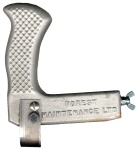 A: The Ringer |
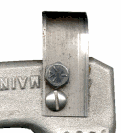 B: Adjustable blade! |
The blade is made out of carbon steel, and is very sharp! Even more cool, you can adjust the blade's angle of attack (pitch angle) by rotating the wing nut at the end of the tool. (I bet you were wondering what that was for!) For very large trees, the blade should be adjusted as in the photograph "A" above. But for smaller trees, the blade should be tilted to a different angle. (See the fun animated Figure "B", above to the right, to see the blade's range of motion.)
Field Tests
I took the Ringer to a number of sites in central California where the native species of plants were being displaced by invasive woody species. I was really curious to see how the Ringer would perform---looking at it in my office, it just did not seem to make sense.
I have to hand it to the Ringer, though. The tool is pretty well balanced, comfortable to hold, and easy to use. After just a few seconds of fumbling around with it, I figured out how it worked and I started slicing big curly sections of bark off my target trees. On relatively thin-barked trees like Ailanthus (Tree-of-Heaven), I could ring the trees just about as quickly as I could maneuver around them. The furrow created by the Ringer was about 1.5 cm wide, but it was trivial to make more than one pass over adjacent areas to make wider passes.
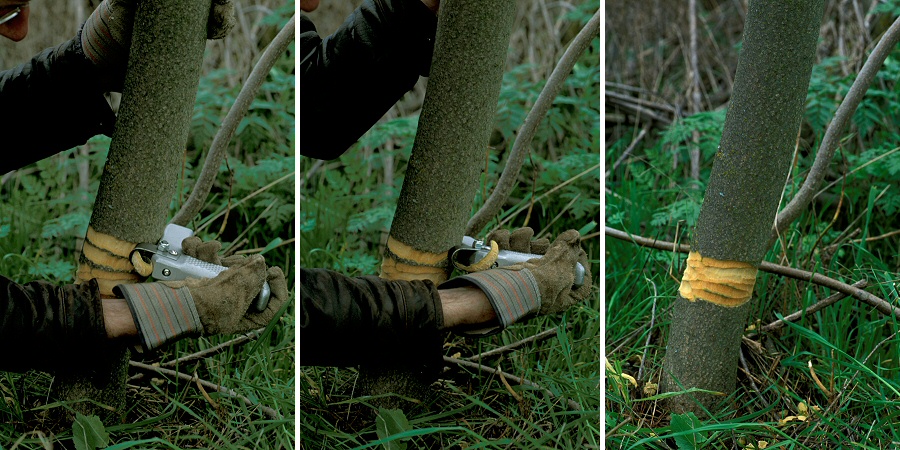 Using the Ringer on a small tree |
Adjusting the wing nut to accommodate different-sized trees was easily done. The wing nut turned easily with finger pressure. Furthermore, I did not detect any drift in the blade angle, i.e. the blade angle did not seem to require any readjustments to stay at the same pitch angle.
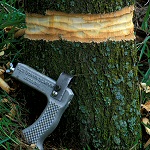 On a medium tree |
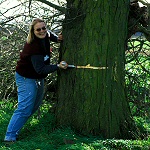 Becky wi/mondo tree |
Trees smaller than about 4cm (1.5 inches) diameter are hard to be treated with the Ringer, but really you can ring such trees with a pocket knife.
| |||||||||||||||||||||||||||
Maintenance
The blade will dull with use, especially if it is used on large trees with hard or thick bark. You can feel a difference after resharpening the blade after even just one long day of work. Jim Dempsey resharpens and cleans his using a round file, flat file, and cleanser like "Goo-Gone." If you break a blade, you can buy a replacement.
Safety Notes
Do not get your fingers near the Ringer's blade. It is very sharp; if you do not respect it and instead do something stupid you could send yourself to the hospital. When using this device, be aware of what that blade would cut into if the Ringer jumped out of its groove as you are pushing it. Wear gloves!
Advantages of the Ringer
- It works well in most cases.
- It is not as dangerous as a chain saw, or even a machete.
- With fewer moving parts than a chain saw, malfunctions are rare.
- Unlike a chain saw, it is quiet to use, so animals are not disturbed.
- Properly used, it can expose a large amount of cambium which is very useful in applying herbicides.
- It is kind of fun to use.
Disadvantages of the Ringer
- At $150, it is expensive.
- Chain saws or machetes have multiple uses. Ringers can only do one thing.
- They are hard to use on trees that have very thick or hard bark, like old almonds or mulberries. (But so are machetes.)
- Not suitable on trees with very complicated surfaces, like twining, multiple trunks or trees with concave surfaces.
Summary
The Ringer is an expensive tool, but it is very useful on a wide range of trees. You can go into the woods and easily girdle trees---especially thin-barked species---quietly and without disturbing wildlife. It is an excellent way to prepare trees for a hack & squirt herbicidal treatment, too. It is pretty cool!
Ordering Information
You can buy the Ringer from Forestry Suppliers, Inc. When you get to that site, do a search on "Ringer". You should see a page for this tool. In May 2003 I successfully did this, and got to this page; but be warned that this url looks like the kind that could change any time without warning. The Ringer's manufacturer has a web site too.
The Ringer costs $149.90, shipping adds about another $10. Replacement blades cost $22.95. As long as you maintain the blade manually by keeping it sharp and clean, you will only need a replacement if something happens like if you run into an old nail or some other odd event.
--Barry Rice, TNC/GIST, May 2003


